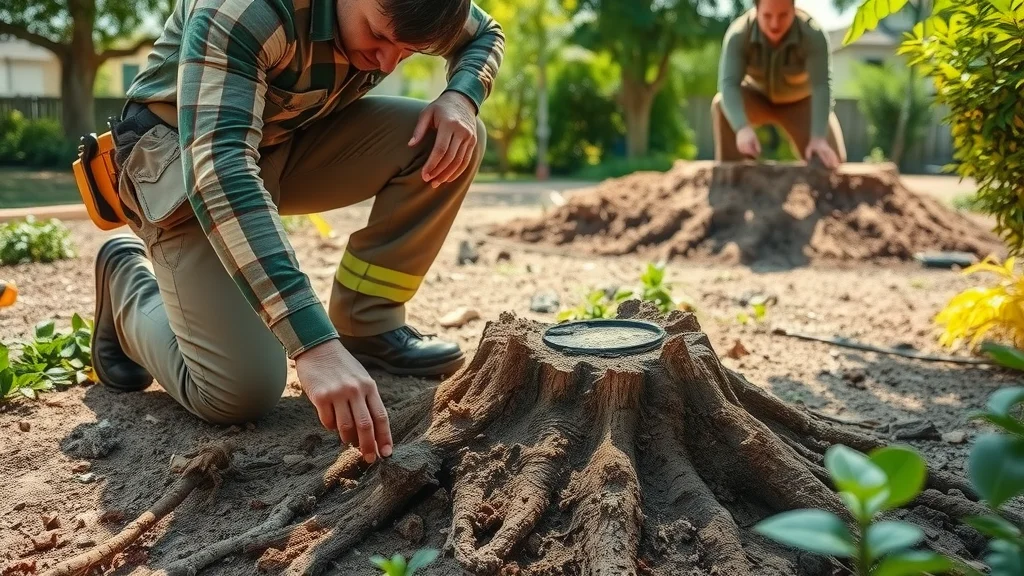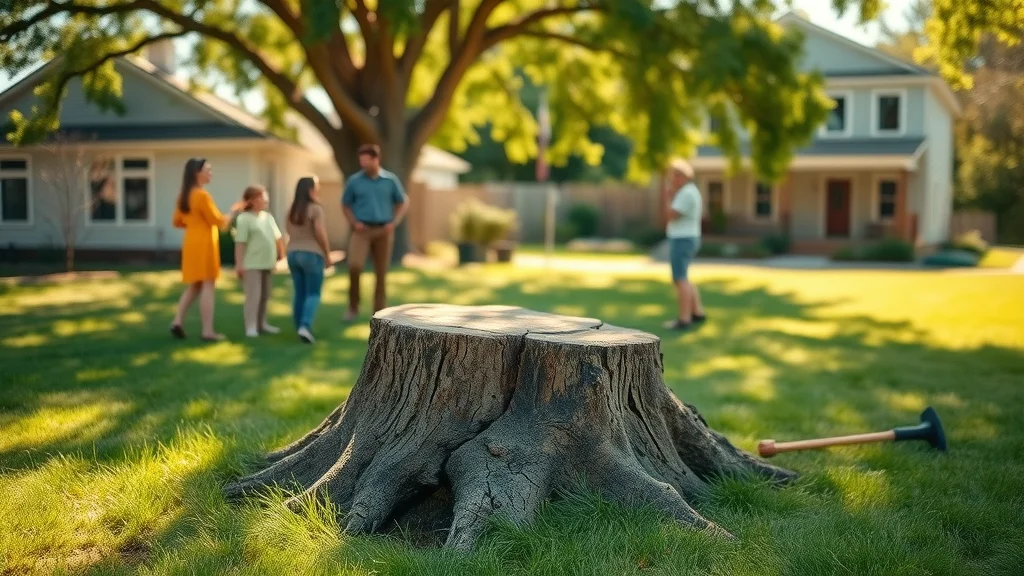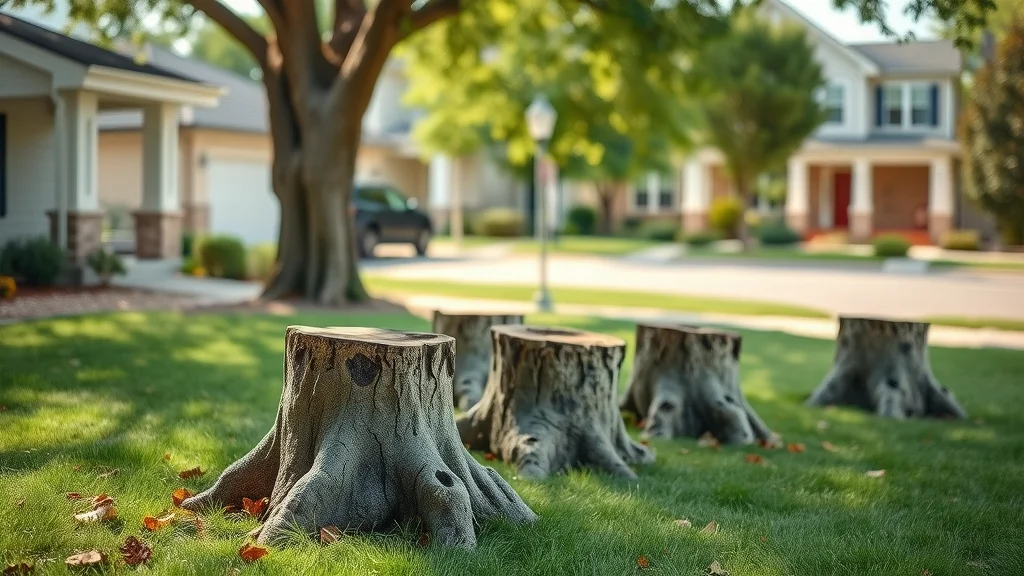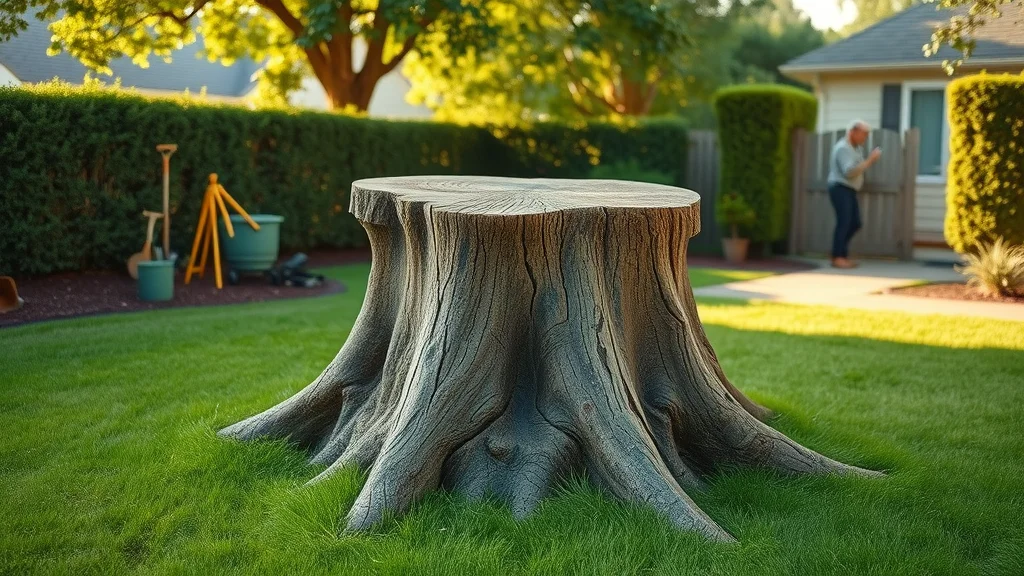Did you know that more than 80% of homeowners make critical mistakes during stump grinding that can cause lasting yard damage and unnecessary costs? When it comes to removing an unsightly tree stump from your yard, there’s a lot more beneath the surface than meets the eye. Stump grinding, while seemingly straightforward, holds many secrets that tree service professionals wish you knew. In this comprehensive guide, you’ll discover the game-changing techniques, essential mistakes to avoid, and insider insights that separate flawless stump removal from expensive disasters. Whether you’re considering hiring a pro, renting a stump grinder yourself, or just curious about the stump grinding process, this article delivers all the facts to help you make informed, cost-effective decisions for your landscape.
Unlocking the Truth Behind Stump Grinding: Surprising Facts and Figures
"More than 80% of homeowners are unaware of the critical mistakes made during a typical stump grinding job—leading to unnecessary risks and long-term yard damage." – Arbor Industry Analyst
Many people assume that stump grinding is simply about making an old tree stump disappear, but the reality is far more complex. Industry research reveals that careless grinding can affect soil health, compromise future landscaping, and even enable pests or fungal regrowth. Professional tree services regularly encounter yards where improper stump grinding has led to uneven ground levels, lingering roots, and environmental hazards.
What often goes unsaid is how the type of stump grinder used, the grind depth, and the cleanup of wood chips can significantly alter your yard’s long-term health and appearance. Whether you’re facing a large stump or just want to avoid common mistakes, understanding the real facts—and not just the sales pitch—can prevent you from being among the majority who pay for preventable issues.
What You'll Learn About Stump Grinding
- The key steps of efficient stump grinding
- Choosing between stump grinder types
- Stump removal alternatives and long-term results
- How to avoid costly stump grinding mistakes
- Tips from tree service professionals

What Exactly Is Stump Grinding and Why Is It Important?
Stump grinding is the process of using powerful, specialized equipment—a stump grinder—to shred the remnants of a tree stump down below ground level. Unlike complete stump removal, which involves extracting the entire stump and its major roots, stump grinding focuses on grinding the stump into wood chips and fine debris until it’s flush with or below the surrounding ground. This method effectively eliminates visible remnants, facilitates landscaping, and avoids the heavy labor and soil disruption of full extraction.
Why is stump grinding crucial? First, old stumps can harbor pests like termites or carpenter ants and provide a breeding ground for fungi that threaten healthy trees nearby. Second, leaving a tree stump disrupts lawn care, creates a trip hazard, and makes landscaping tricky. Efficient stump grinding prevents these issues, saves you money in the long run, and ensures a safer, more attractive outdoor space. The process also yields helpful wood chips for mulching or compost, turning waste into a gardening asset.
Stump Grinding vs. Stump Removal
The debate between stump grinding and stump removal comes down to invasiveness and landscape goals. While stump grinding uses a stump grinder to reduce the tree stump to ground level and below, it leaves the larger roots in place to decay naturally. By contrast, stump removal involves extracting both the stump and major roots, which requires heavy machinery, causes more yard disruption, and often leads to higher costs.
Stump grinding is typically preferred for residential yards because it offers a less disruptive, faster, and more affordable option. However, for situations where new construction, paving, or deep-rooted planting is planned, complete stump removal may be necessary. Understanding these differences ensures you select the right tree service for your needs, whether you want low-impact landscaping or a fresh slate below the soil.
The Role of the Stump Grinder in Modern Tree Service
In today's tree service industry, the stump grinder is indispensable. Modern stump grinders come in various sizes, from compact units for narrow access backyards to powerful machines designed to tackle large stumps left after mature tree removal. These machines use rotating cutting wheels with carbide teeth to chip away at the wood until it’s transformed into mulch or wood chip debris.
Innovations in stump grinder design have made the process safer, quicker, and less damaging to the surrounding landscape. A skilled operator can safely grind a stump to the desired depth, usually 4–16 inches below ground level, preventing regrowth. Using a professional-grade stump grinder also minimizes the risk of injury and ensures compliance with safety standards, making it a staple for tree services and homeowners alike.

Types of Stump Grinder: Which One Should You Use?
Selecting the right stump grinder for your job is a vital step that’s often overlooked. There are several types of stump grinder: hand-guided, walk-behind, and larger self-propelled machines. Each type serves a different purpose, depending on the size of the tree stump, access to the yard, and the desired end result. The choice also impacts time, cost, and the level of effort needed, so understanding the pros and cons can mean the difference between a simple Saturday project and a costly headache.
For small backyards or tight spots, a compact or hand-held stump grinder gets the job done with minimal disturbance. For large stumps or multiple stumps, a wheeled, heavy-duty or vertical stump grinder could be the best solution. The decision can also depend on whether you’re hiring a pro—who may have access to specialized equipment—or tackling the project yourself. Matching the grinder to the job ensures safe, thorough, and efficient stump grinding.
Vertical Stump Grinder vs. Standard Stump Grinder
A vertical stump grinder is engineered for speed and effectiveness with deeply rooted or especially tough tree stumps. Unlike standard grinders that operate horizontally by chipping away across the surface, vertical grinders attack from above, drilling deeper and reducing massive stumps more rapidly. This makes them ideal for commercial or professional tree services tackling particularly stubborn or oversized stumps after tree removal.
On the other hand, standard walk-behind or self-propelled grinders are more versatile for most residential needs. They shine for average-size stumps where ground disruption should be minimal and clean up is a concern. Your choice depends on the types of stump encountered and the width, depth, and accessibility of the stump site. When in doubt, consulting a professional ensures the right machine is selected for your specific project.
Suitability of Stump Grinders for Different Tree Stump Situations
Not all stump grinders and tree stump scenarios are created equal. For smaller, weathered stumps or tight urban settings, a compact or handheld grinder usually suffices. However, fresh tree stumps—especially from large hardwoods—require powerful, self-propelled machines or vertical grinders that penetrate deeper and work faster. The soil type, location (such as near fences or utility lines), and the presence of stones or roots also influence which grinder should be used.
Professionals factor in risks like potential regrowth or residual roots that could compromise future landscaping. If you’re removing a large stump after tree removal, or dealing with multiple stumps, commercial-grade grinders offer efficiency and thoroughness that smaller units can’t match. Understanding these suitability guidelines means you’ll spend less time and money, and enjoy better long-term results from your stump grinding project.
| Type of Stump Grinder | Best For | Average Rental Cost (Per Day) | Pros | Cons |
|---|---|---|---|---|
| Handheld/Compact | Small stumps, tight spaces | $75–$125 | Affordable, easy to maneuver | Limited depth, slow on large stumps |
| Walk-behind/Standard | Average residential stumps | $95–$200 | Efficient, widely available | Requires physical effort, not suited for massive stumps |
| Self-Propelled/Commercial | Large stumps, multiple stumps | $250–$400 | Powerful, deep grinding, professional results | Expensive, larger learning curve |
| Vertical Stump Grinder | Deep-rooted or very large stumps | Special order/pro only | Deep penetration, very efficient for big jobs | Not for DIY, usually only with tree services |

The Step-by-Step Stump Grinding Process Explained
- Initial assessment of the tree stump: Begin by evaluating the tree stump for size, type, age, and condition. Determine how deep to grind and check for rocks or obstructions around and beneath the stump. Look for nearby trees, garden beds, or infrastructure that could be affected.
- Preparation and safety checks: Clear the area of debris, mark utilities, and establish protective barriers. Don’t forget essential protective equipment—helmet, gloves, and safety glasses—to safeguard against flying wood chips and machine mishaps.
- Using the stump grinder effectively: Position the grinder over the stump and operate according to the manufacturer’s instructions. Work in slow, sweeping arcs to chip down inches at a time, aiming to reach the recommended depth below ground level. Continually check for hidden roots or objects that might jam the grinder.
- Debris management after stump grinding: Once complete, shovel away the mound of wood chips and sawdust. You can use them for mulch or compost, or have them hauled away by your tree service. Fill the hole with fresh soil for a seamless yard finish and to support future landscaping.
Each step requires patience and attention to detail for both safety and landscape integrity. Skipping preparation, misusing equipment, or neglecting cleanup is how most issues—and homeowner regrets—arise during stump grinding.
For a deeper dive into how stump grinding can transform your yard and the specific hazards it helps you avoid, you might find it helpful to review the key reasons not to delay stump grinding and the hidden dangers it prevents. This resource offers practical insights that complement the step-by-step process outlined here.
Top Secrets Professionals Don’t Share About Stump Grinding
- Hidden risks in improper stump grinding: Shallow grinding risks regrowth or, worse, fungal infestations that may jeopardize nearby plants. Many homeowners are surprised when mushrooms or shoots appear months later—an avoidable outcome with thorough grinding.
- Soil, root, and regrowth considerations: Pros always assess how the roots of a removed tree connect with the surrounding landscape. Sometimes, grinding too shallow leaves root remnants that encourage pest activity or destabilize soil structure.
- Best times for efficient stump removal: Most professionals recommend grinding in late fall or early spring when the ground is firm but not frozen, reducing mess and ensuring machinery runs smoothly.
- Stump grinding tips from leading tree services: Experienced arborists rotate grinder teeth frequently and avoid wet weather to ensure finer wood chip debris and less yard disruption.
"The techniques we use today in stump grinding prevent issues that can show up years later in your landscape." – Certified Arborist

Essential Safety Tips for Effective Stump Removal
- Protective gear for operators: Always wear sturdy boots, gloves, a helmet, and high-quality eye protection. Using the right protective equipment shields you from flying wood chips and machine debris.
- Safe stump grinder handling procedures: Read all operational manuals. Use both hands on controls, keep bystanders away, and always power down before servicing or repositioning the grinder. Never attempt to dislodge jammed wood chips with the machine active.
- Managing potential hazards around the worksite: Clear stones, glass, and metal from the zone, and mark all underground utility lines before grinding. Creating an organized, hazard-free area around the tree stump drastically lowers injury risk and equipment damage, whether you’re a do-it-yourselfer or hiring a professional.

Should You Hire a Pro or DIY Your Stump Grinding?
Deciding between hiring a pro or tackling stump grinding as a DIY project hinges on cost, expertise, and risk tolerance. Professionals bring specialized equipment, years of experience, and full insurance coverage—meaning faster, safer results and protection from accidental property damage. DIY options save on labor but often result in rental and transportation fees, and expose you to learning curves and safety hazards.
For small or accessible stumps, a competent homeowner can rent a stump grinder from a local supplier and finish the job with some effort. For complex removals, multiple tree stumps, or scenarios near structures or underground utilities, hiring a professional arborist or tree service is the safer choice. Always compare rental and service quotes, factoring in equipment size and your own risk comfort.
Pros and Cons: Hiring a Pro vs. DIY Stump Grinding
Hiring a pro ensures the fastest, cleanest, and least risky outcome—with the added benefit of professional cleanup and soil restoration. Professional tree services know how to match grinder types to each unique tree stump situation, reducing the chances of overlooked roots or soil problems.
DIY stump grinding can be rewarding and budget-friendly for smaller jobs, but mishandling machinery or misjudging grinding depth can result in lingering stumps, regrowth, or personal injury. Remember, stump grinders are powerful machines that demand respect, focus, and proper protective equipment.
Average Costs for Stump Grinding Services
The average national cost to grind a stump ranges between $100 and $400 for a single, accessible stump. Prices may rise to $600 or more for large stumps or if extensive root systems or hard-to-reach areas are involved. Variables include the size of the tree, site accessibility, root complexity, and the specific services offered (such as wood chip removal or ground restoration).
By comparison, DIY stump grinder rentals cost on average $100–$400 per day, plus transport and potential damage deposits. Be sure to factor in your time and possible rework due to inexperience or equipment limitations. For multiple tree stumps or those in sensitive locations, professional tree service is often worth the investment due to efficiency, speed, and peace of mind.
| Solution | Average Time (Per Stump) | Estimated Cost | Skill Required | Risk Level |
|---|---|---|---|---|
| DIY Rental | 2–6 hours | $100–$400/day | Moderate—must read all instructions and practice safety | Medium to High |
| Pro Tree Service | 30 min–2 hours | $100–$600+ | None (leave it to professionals) | Low |
Stump Grinding Aftercare: What Comes Next?
- How to use stump remover for complete removal: For any persistent root fragments or leftover wood, applying a chemical stump remover can help break down material that a grinder couldn’t reach. Just follow all manufacturer and environmental guidelines for safe and responsible use.
- Preventing tree stump regrowth: To stop the return of unwanted shoots, be sure the grinding removes the stump at least 6–12 inches below ground level, and check the site for active root growth. Occasionally, using a root barrier or targeted herbicide is warranted, especially near lawns or gardens.
- Landscaping options post-stump removal: Once the hole is backfilled, you can replant grass, create a flower bed, or install a new tree in the cleared spot. Fresh wood chips can be used as mulch elsewhere—but be mindful they decompose over time, altering soil nitrogen levels. Healthy aftercare ensures your yard fully recovers and looks better than ever.

People Also Ask: Stump Grinding Questions Answered
How much does it usually cost to grind a stump?
Professional stump grinding services typically cost $100–$400 per stump, depending on the size of the tree, accessibility, and depth. Difficult or extensive root systems, multiple tree stumps, or removal of large wood chip debris can push prices higher. Always request detailed quotes from multiple tree service providers before making a decision.
Can you grind a stump yourself?
Yes, you can grind a stump yourself by renting a stump grinder from a hardware or garden center. While it’s cost-effective for small, accessible stumps, it requires strength, careful safety practice, and a willingness to learn. Be mindful that mishandling equipment or underestimating the project can result in injury or incomplete stump removal.
Is stump grinding worth the cost?
For most homeowners, stump grinding is absolutely worth the investment. It eliminates eyesores, prevents pest and fungal problems, and increases yard usability. Professional grinders work faster and deeper than most rental units, ensuring lasting results and preserving your landscape’s value.
Is it better to grind or dig out stumps?
It depends on your goals. Grinding is usually best for average yards—it’s cleaner, less disruptive, and affordable. Digging out stumps removes all roots and is best when replanting large trees or constructing foundations, but it’s labor-intensive and can damage the surrounding area. Most homeowners find stump grinding the best all-around solution.
Stump Grinding FAQs for Homeowners
- How deep should the stump be ground? Grind at least 6–12 inches below ground level for effective prevention of regrowth and future landscaping ease.
- Do stump grinders remove all roots? No, stump grinders mainly target the wood above ground and just below surface level. Major roots remain and decay over time, though deeper grinding can address more root material.
- Is there an eco-friendly way to do stump removal? Yes! Use the wood chips as mulch, let roots decompose naturally, and avoid chemical stump removers unless absolutely necessary for regrowth control.
- What risks are involved in improper stump grinding? Regrowth, fungal infestations, pest attraction, soil instability, and even damage to underground utilities—all can result from hasty or shallow grinding. Follow safety protocols and hire pros when in doubt.
Key Takeaways From Stump Grinding Secrets
- Thorough planning and the right stump grinder are crucial for safe, efficient removal.
- Professional stump grinding offers efficiency and safety, saving time and reducing risk.
- Long-term benefits depend on expert techniques that prevent regrowth and soil issues.
If you’re ready to take your landscaping results to the next level, there’s even more to discover about achieving a flawless yard after stump removal. Explore how the magic of stump grinding can unlock new possibilities for your outdoor space—from advanced aftercare to creative landscaping ideas. This next step will help you maximize the value of your investment and ensure your yard remains healthy, beautiful, and hazard-free for years to come. Dive deeper and transform your landscape with expert-backed strategies and inspiration.
 Add Row
Add Row  Add
Add 




Write A Comment